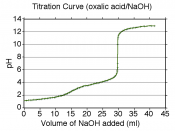1.0Theory1.1Acids and basesAn acid is any chemical compound that, when dissolved in water, gives a solution with a pH less than 7.0. It is also a compound which donates a hydrogen ion (H+) to another compound (called a base).
Generally, acids have the following properties:ÃÂTaste: Acids generally have a sour tasteÃÂTouch: Strong or concentrated acids often produce a stinging feeling on mucous membranesÃÂReactivity: Strong acids react aggressively with or corrode many metalsÃÂElectrical conductivity: Acids, while not usually ionic compounds, are electrolytesÃÂAcids turn moist blue litmus paper redIn chemistry, a base is most commonly thought of as a substance that can accept protons. This refers to the Brønsted-Lowry theory of acids and bases. Alternate definitions of bases include electron pair donors. Bases can be thought of as the chemical opposite of acids. A reaction between an acid and base is called neutralization. Bases and acids are seen as opposites because the effect of an acid is to increase the hydronium ion (H3O+) concentration in water, whereas bases reduce this concentration.
Some general properties of bases include:ÃÂTaste: Bitter taste (opposed to sour taste of acids and sweetness of aldehydes and ketones)ÃÂTouch: Slimy or soapy feel on fingersÃÂReactivity: Caustic on organic matter, react violently with acidic substancesÃÂElectric conductivity: Aqueous solutions or molten bases dissociate in ions and conduct electricityÃÂBases turn red litmus paper blue1.2CarbonationBubbles of carbon dioxide float to the surface of a soft drink. Carbonation occurs when carbon dioxide is dissolved in water or an aqueous solution. Effervescence is the escape of gas from an aqueous solution. The term is usually used to describe the foaming or fizzing that results from gas. This process is generally represented by the following reaction, where a pressurized dilute solution of carbonic acid in water releases gaseous carbon dioxide at decompression:In simple terms, it is the...

![Copper mining and sulfuric acid plant, Copperhill], Tenn. (LOC)](https://s.writework.com/uploads/3/32663/copper-mining-and-sulfuric-acid-plant-copperhill-tenn-loc-thumb.jpg)
